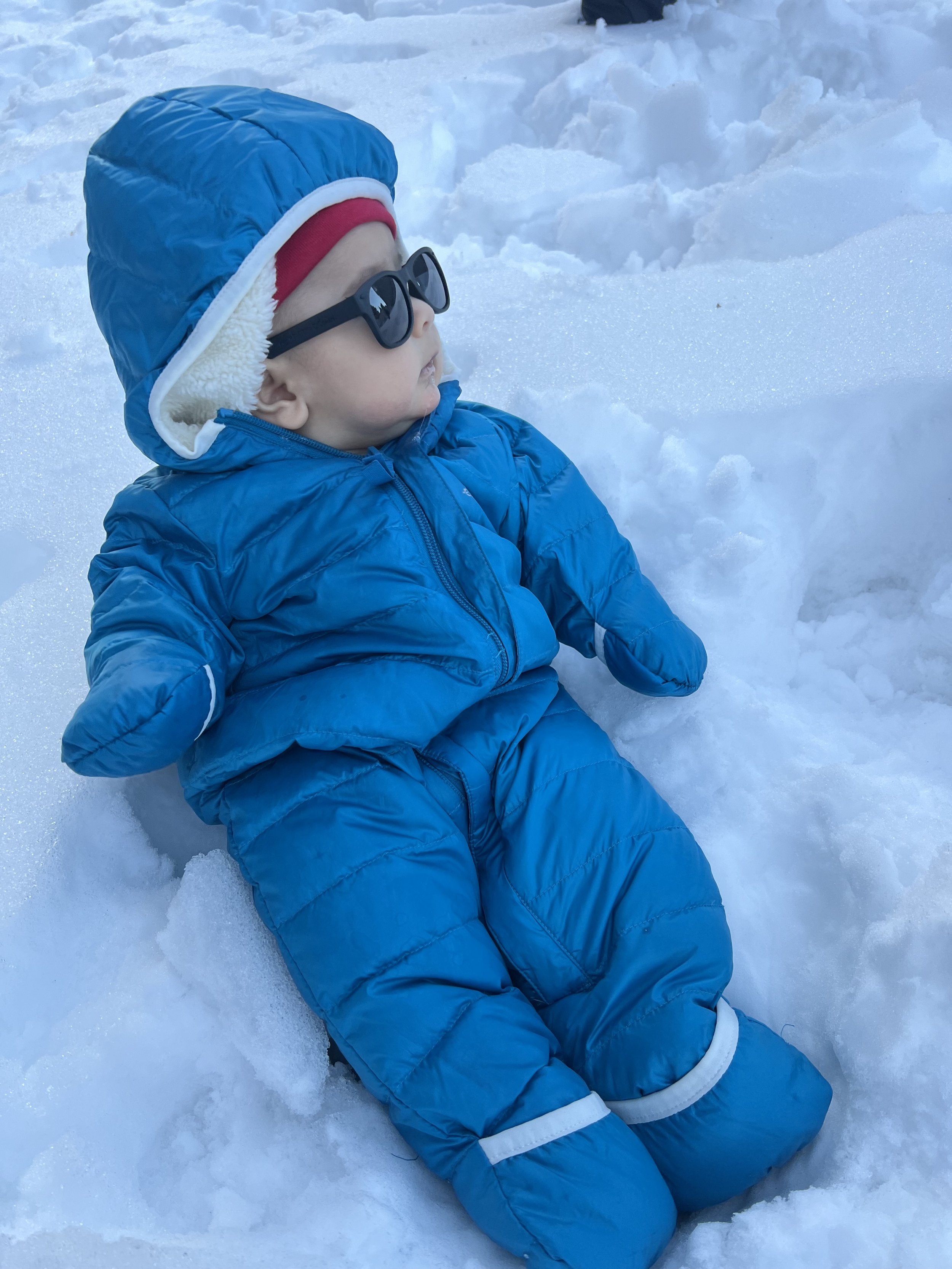Going to the Mountains with my 4 Month Old
I told myself when I was pregnant that when my baby comes out, my adventures aren’t going to stop. He is just going to go with me, and that is what I did! Snow hit the mountain tops and for our first big adventure together, we went for my first time back on the board since being pregnant and baby J’s first snow! Elevation at Mammoth Village is nearly 8000 feet. Coming from sea level, I took to google to see what the consensus was about taking my new adventure buddy along and everywhere I looked said that as long as the baby is 3 months or older, they are fine. Any younger and their lungs aren’t mature enough to acclimate to the high altitude. With that, I packed all of baby J’s warm clothes, toys, and essentials into the car and off we went. What was usually a 4.5 hour drive ended up being about 6.5 hours because I had to stop twice to feed him (and me), change his diaper and get him out of the car seat. Personally, I do not like to keep him in the seat for longer than 2 or so hours at a time. The altitude did not seem to bother my baby at all, or the cold but there were a few key things I noticed…
Here are my 4 things to take into consideration (including links to items I used)
Altitude change - Do your ears get uncomfortable when you are climbing or descending in elevation? For most of us, the answer is yes and it is the same for baby. I noticed that as we climbed on our drive, baby J would get a little fussy and jolt himself up from his slumber. At the next stop, I would let him nurse and he seemed to get comfortable again. I had to stop a couple times as we climbed to give him some comfort. Encouraging babies to swallow as the elevation changes clears their ears. A pacifier also helps with clearing the ears if baby takes to those, mine isn’t a fan.
How was I sure that it was the pressure in his ears and not him actually being hungry? To be fair, since a 4 month old can’t tell you what is actually going on, we as parents can only infer. Baby J usually eats in 4 hour intervals during the day but on a 4.5 hour drive, I had to stop twice and he ate less than he normally does.
Dehydration - Mountain air is extremely dry. For our throats, for our skin, for our noses. Even for us adults, when we travel to higher elevations, a little itch tickles the back of our windpipe that can only be soothed by drinking lots of water and liquids. Our skin thirsts for moisture and our noses get flaky or crack, mine start to bleed on occasion. Imagine what that feeling would be like for a tiny Lil baby! Everything is so much more sensitive for a baby than for us and since my baby is solely being breastfed, I had to feed him a little more often to keep him hydrated. Normally, baby J eats every 4 hours during the day and will, mostly, go 5-6 hours before waking up to eat. Up in the mountain, he was wanting to feed every 2 to 3 hours, even in the middle of the night. And for us breast feeding mamas, make sure to take care of your own hydration too! Being dehydrated can affect milk supply!
I was also making sure to apply moisturizing lotion to baby J often as I noticed his skin getting dry, especially on his cheeks. For his nose, I made sure to pack baby saline to keep those nasal passages moisturized and clear.
Dressing warmly - The rule of thumb I was seeing online on how to dress an infant in cold weather was to consider what I would be wearing, then add an extra layer for him. So that is what I did. Remember, babies aren’t moving around like we are, so they will feel colder than we do as our movements generate heat.
Since I was wearing a sports bra, thermal, a bib and jacket, I had him wear a long sleeve bodysuit, a full onesie with feet, a bunting and a beanie and he seemed very comfortable and content. Always pack more than you think you’ll need because more often than not, you’ll end up needing it!
Note: do not drive with the baby wearing the puffy in the car seat as the extra bulk leaves the straps too loose and ineffective in the event of a car crash
Skin/Eye Protection - Baby skin and eyes are so sensitive! My doctor said baby skin shouldn't even be exposed to sun until they are at least 6 months old so I try to make sure I cover him up very well when outside, in layers depending on the weather. At higher elevations, the sun is closer and very intense so it is that much more imperative that we protect baby’s skin from any damage or burns. A few springs back, I was wearing a tank top snowboarding and I did not bring sunscreen on the mountain with me to reapply and…. that is a mistake I will never make again for myself and a lesson learned to protect my previous baby. With all of his layers, the majority of baby J’s skin was covered but his face was exposed so I made sure to put a light layer of baby safe sunscreen on his face (just for peace of mind in case we couldn’t keep him completely out of the sun) and he wore sunglasses to protect his beautiful eyes.



